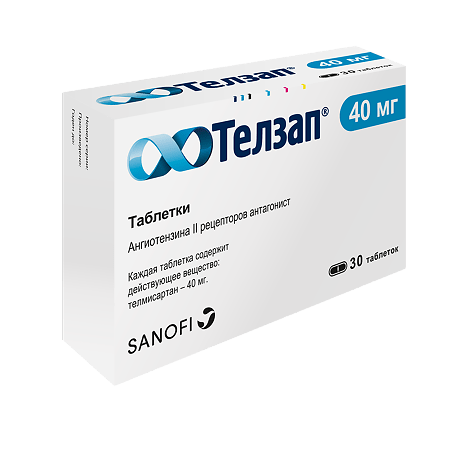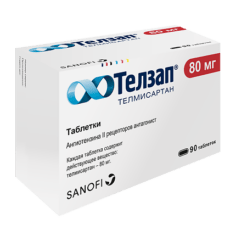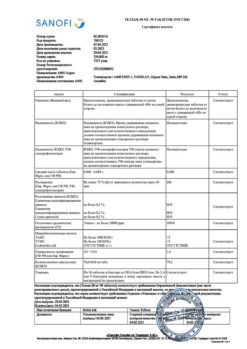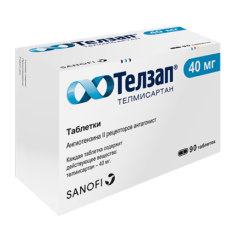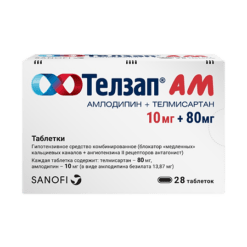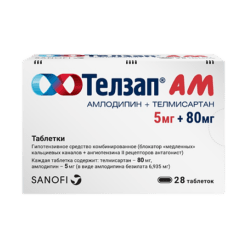No products in the cart.
Telzap, tablets 40 mg 30 pcs
€12.54 €10.97
Description
Pharmacodynamics
Telmisartan is a specific angiotensin II receptor antagonist (type ATi) effective when taken orally. Telmisartan has a very high affinity for AT| receptors, through which angiotensin II action is realized. It displaces angiotensin II from binding to the receptor with no agonist effect against this receptor. Telmisartan binds only to the AT| subtype of angiotensin II receptor. The binding is stable.
Telmisartan has no affinity for other receptors, including the AT2 receptor and other less studied angiotensin receptors. The functional significance of these receptors, as well as the effect of their possible overstimulation by angiotensin II, the concentration of which increases with telmisartan administration, has not been studied. Telmisartan reduces plasma aldosterone concentration, does not reduce renin activity and does not block ion channels. Telmisartan does not inhibit angiotensin-converting enzyme (ACE) (kininase II), which also catalyzes the destruction of bradykinin. This avoids side effects associated with bradykinin action (e.g., dry cough).
Essential hypertension
In patients, telmisartan at a dose of 80 mg completely blocks the hypertensive effects of angiotensin II. The onset of antihypertensive action is noted within 3 h after the first dose of telmisartan. The action of the drug persists for 24 h and remains clinically significant up to 48 h. Significant antihypertensive effect usually develops 4-8 weeks after regular use.
In patients with arterial hypertension, telmisartan reduces systolic and diastolic blood pressure (BP) without affecting heart rate (HR).
In case of abrupt discontinuation of telmisartan BP gradually returns to baseline within a few days without development of “withdrawal” syndrome.
As the results of comparative clinical studies have shown, the antihypertensive effect of telmisartan is comparable to other classes of drugs (amlodipine, atenololol, enalapril, hydrochlorothiazide and lisinopril).
The incidence of dry cough was significantly lower with telmisartan compared with ACE inhibitors.
The prevention of cardiovascular disease
. In patients aged 55 years or older with coronary heart disease, stroke, transient ischemic attack, peripheral artery disease, or with a history of complications of type 2 diabetes mellitus (e.g., retinopathy, left ventricular hypertrophy, macro- or microalbuminuria) at risk for cardiovascular events, telmisartan had similar effects to ramipril in reducing the combined end point cardiovascular mortality from nonfatal myocardial infarction, nonfatal stroke, and hospitalization for chronic heart failure.
Telmisartan was as effective as ramipril in reducing the incidence of secondary points: cardiovascular mortality, nonfatal myocardial infarction, or nonfatal stroke. Dry cough and angioedema were less often described with telmisartan compared to ramipril, while arterial hypotension occurred more frequently with telmisartan.
Patients in children and adolescents
The safety and efficacy of telmisartan in children and adolescents younger than 18 years have not been established.
Pharmacokinetics
Assimilation
Telmisartan is rapidly absorbed from the gastrointestinal tract when ingested. Bioavailability is 50%. When taken concomitantly with food the AUC (area under the curve “concentration-time”) decrease varies from 6% (at a dose of 40 mg) to 19% (at a dose of 160 mg). Three hours after administration, plasma concentrations level off, whether or not telmisartan is taken concomitantly with food. There is a difference in plasma concentrations between men and women. Stath (maximum concentration) and AUC were approximately 3 and 2 times higher in women compared to men, respectively, with no significant effect on efficacy.
No linear relationship between drug dose and plasma concentration was observed. The rates and, to a lesser extent, the AUC increase disproportionately when doses above 40 mg daily are used.
Distribution
Telmisartan binds firmly to plasma proteins (>99.5%) primarily to albumin and alpha-1 acid glycoprotein. The average apparent volume of distribution (Vdss) in the equilibrium state is approximately 500 liters.
Metabolism
Metabolized by conjugation with glucuronic acid. The conjugate has no pharmacological activity.
Elimination
The elimination half-life (T./2) is more than 20 hours. Excretion is through the intestine unchanged, renal excretion is less than 1%. Total plasma clearance is high (about 1000 ml/min) compared to “hepatic” blood flow (about 1500 ml/min).
Indications
Indications
– essential hypertension;
– reduction in mortality and incidence of cardiovascular disease in adult patients with cardiovascular disease of atherothrombotic genesis (CHD, stroke or peripheral artery disease in the history) and with type 2 diabetes with target organ damage.
Active ingredient
Active ingredient
Composition
Composition
Associates:
Meglumine – 12 mg,
sorbitol – 162.2 mg,
sodium hydroxide – 3.4 mg,
povidone 25 – 20 mg,
magnesium stearate – 2.4 mg.
How to take, the dosage
How to take, the dosage
The drug is taken orally, once daily, regardless of meals; tablets should be washed down with fluids.
Hypertension
The initial recommended dose of Telzap is 40 mg (1 tablet) once daily. In some patients it may be effective to take the drug in a dose of 20 mg/day. A dose of 20 mg can be obtained by dividing the 40 mg tablet in half at risk. In cases where the therapeutic effect is not achieved, the recommended dose of Telzap may be increased to a maximum dose of 80 mg once daily.
Alternatively, Telzap may be taken in combination with thiazide diuretics such as hydrochlorothiazide, which had an additional antihypertensive effect when used together. When deciding whether to increase the dose, it should be taken into account that the maximum antihypertensive effect is usually achieved within 4-8 weeks after the start of treatment.
Lower mortality and incidence of cardiovascular disease
The recommended dose of Telzap is 80 mg once daily. In the initial period of treatment, monitoring of BP is recommended; correction of hypotensive therapy may be necessary.
The experience with telmisartan in patients with severe renal impairment or patients on hemodialysis is limited. A lower starting dose of 20 mg/day is recommended in these patients. No dose adjustment is required in patients with mild to moderate renal impairment.
The concomitant use of Telzap with aliskiren is contraindicated in patients with renal insufficiency (FFR less than 60 ml/min/1.73 m2 body surface area).
The concomitant use of Telzap with ACE inhibitors is contraindicated in patients with diabetic nephropathy.
Patients with mild to moderate hepatic impairment (Child-Pugh Class A and B) should use the drug with caution and the dose should not exceed 40 mg once daily. Telzap is contraindicated in patients with severe hepatic insufficiency (Child-Pugh class C).
Dose adjustment is not required in elderly patients.
The use of Telzap in children and adolescents under 18 years of age is contraindicated due to the lack of safety and efficacy data.
Interaction
Interaction
The dual blockade of the angiotensin-aldosterone system (RAAS) Concomitant use of telmisartan with aliskiren is contraindicated in patients with diabetes mellitus or renal impairment (FFR less than 60 ml/min/1.73 m2 body surface area) and is not recommended in other patients.
The concomitant use of telmisartan and ACE inhibitors is contraindicated in patients with diabetic nephropathy (see section “Contraindications”).
The data from clinical studies have demonstrated that dual RAAS blockade due to combined use of ACE inhibitors, APAP or aliskiren is associated with an increased incidence of adverse events such as arterial hypotension, hyperkalemia and renal impairment (including acute renal failure) compared to use of a single drug acting on RAAS alone.
. The risk of hyperkalemia may increase when coadministered with other medications that can cause hyperkalemia (potassium-containing supplements and salt substitutes containing potassium, potassium-saving diuretics (e.g, spironolactone, eplerenone, triamterene, or amiloride), nonsteroidal anti-inflammatory drugs (NSAIDs, including selective cyclooxygenase-2 (COX-2) inhibitors), heparin, immunosuppressants (cyclosporine or tacrolimus), and trimethoprim). If necessary, against the background of documented hypokalemia, co-administration of drugs should be performed with caution and plasma potassium content should be regularly monitored.
Digoxin
When telmisartan was coadministered with digoxin, there was an average increase of 49% in plasma digoxin rates and a minimum concentration of 20%. Plasma digoxin concentrations should be carefully monitored at initiation of treatment, dose selection, and discontinuation of telmisartan treatment to maintain them within the therapeutic range.
Kalium-saving diuretics or potassium-containing supplements Angiotensin II receptor antagonists, such as telmisartan, reduce diuretic-induced potassium loss. Potassium-saving diuretics such as spironolactone, eplerenone, triamterene, or amiloride, potassium-containing supplements, or salt substitutes may result in a significant increase in plasma potassium. If concomitant use is indicated because there is documented hypokalemia, they should be used with caution and with regular monitoring of plasma potassium.
Lithium preparations
The co-administration of lithium preparations with ACE inhibitors and ARAS, including telmisartan, has resulted in reversible increases in plasma lithium concentrations and its toxic effects. If it is necessary to use this combination of drugs, it is recommended to carefully monitor plasma lithium concentrations.
Non-steroidal anti-inflammatory drugs (NSAIDs)
NSAIDs (i.e., acetylsalicylic acid in doses used for anti-inflammatory treatment, COX-2 inhibitors and non-selective NSAIDs) may impair the antihypertensive effect of ARAP. In some patients with impaired renal function (e.g., patients with dehydration, elderly patients with impaired renal function), coadministration of ARAP and drugs that inhibit cyclooxygenase-2 may lead to further deterioration of renal function, including the development of acute renal failure, which is usually reversible. Therefore, coadministration of drugs should be used with caution, especially in elderly patients. Adequate fluid intake should be ensured, and renal function parameters should be monitored at the beginning of coadministration and periodically thereafter.
Diuretics (thiazide or “loop diuretics”
Previous treatment with high doses of diuretics such as furosemide (“loop diuretic”) and hydrochlorothiazide (thiazide diuretic) can lead to hypovolemia and risk of arterial hypotension at the start of telmisartan treatment.
Other hypotensive drugs
The effect of telmisartan may be enhanced when other hypotensive drugs are used together.
Based on the pharmacological properties of baclofen and amifostine, it can be assumed that they will enhance the therapeutic effect of all hypotensive drugs, including telmisartan. In addition, orthostatic hypotension may be increased with alcohol, barbiturates, narcotics or antidepressants.
Corticosteroids (for systemic use)
Corticosteroids impair the effects of telmisartan.
Special Instructions
Special Instructions
Hepatic impairment
The use of Telzap is contraindicated in patients with cholestasis, biliary obstruction or severe hepatic impairment (Child-Pugh class C) because telmisartan is mainly excreted with bile. It is assumed that hepatic clearance of telmisartan is reduced in such patients. Telzap should be used with caution in patients with mild to moderate hepatic impairment (Child-Pugh grades A and B).
Renovascular hypertension
Patients with bilateral renal artery stenosis or artery stenosis of the only functioning kidney have an increased risk of severe arterial hypotension and renal failure when treated with drugs acting on the RAAS.
Renal dysfunction and renal transplantation
In patients with renal dysfunction, periodic monitoring of plasma potassium and creatinine is recommended during use of Telzap. There is no experience in clinical use of Telzap in patients with recent kidney transplantation.
Limited arterial hypotension, especially after the first administration of Telzap, may occur in patients with decreased RBC and/or plasma sodium content on the background of previous diuretic treatment, restriction of table salt intake, diarrhea or vomiting. Such conditions (fluid and/or sodium deficiency) should be eliminated before starting Telzap.
Double RAS blockade
The concomitant use of telmisartan with aliskiren is contraindicated in patients with diabetes mellitus or renal impairment (FFR less than 60 ml/min/1.73 m2 body surface area).
The concomitant use of telmisartan and ACE inhibitors is contraindicated in patients with diabetic nephropathy.
As a result of RAAS inhibition arterial hypotension, syncope, hyperkalemia and renal dysfunction (including acute renal failure) have been reported in prone patients, especially when multiple drugs also acting on this system are used together. Therefore dual blockade of the RAAS (e.g. with telmisartan with other RAAS antagonists) is not recommended.
In cases where vascular tone and renal function are predominantly dependent on RAAS activity (e.g., in patients with chronic heart failure or renal disease including in patients with renal artery stenosis or stenosis of the artery of the only kidney), the administration of drugs affecting this system may be accompanied by the development of acute arterial hypotension, hyperazotemia, oliguria, and in rare cases, acute renal failure.
Primary hyperaldosteronism
In patients with primary hyperaldosteronism, treatment with hypotensive drugs that work by inhibiting the RAAS is usually ineffective. Due to this reason the use of Telzap is not recommended.
Aortic and mitral valve stenosis, hypertrophic obstructive cardiomyopathy
As with other vasodilators, patients with aortic or mitral stenosis and hypertrophic obstructive cardiomyopathy should be particularly cautious when using Telzap.
Patients with diabetes mellitus who have received insulin or oral hypoglycemic agents
Hypoglycemia may occur in these patients during treatment with Telzap. Glycemic control should be strengthened, since it may be necessary to adjust the dose of insulin or hypoglycemic agents.
Hyperkalemia
The use of drugs acting on the RAAS may cause hyperkalemia. In elderly patients, patients with renal insufficiency or diabetes mellitus, patients taking medications that increase plasma potassium content, and/or patients with comorbidities, hyperkalemia can lead to death.
When deciding on concomitant use of drugs acting on the RAAS, the risk-benefit ratio should be assessed. The main risk factors for hyperkalemia that should be considered are:
– diabetes mellitus, renal failure, age (patients older than 70 years);
– combination with one or more RAAS-acting drugs and/or potassium-containing supplements. Drugs or therapeutic classes of drugs that may cause hyperkalemia are potassium-containing salt substitutes, potassium-saving diuretics, ACE inhibitors, angiotensin II receptor antagonists, NSAIDs (including selective COX-2 inhibitors), heparin, immunosuppressants (cyclosporine or tacrolimus), and trimethoprim;
– intercurrent diseases, especially dehydration, acute heart failure, metabolic acidosis, renal dysfunction, cytolysis syndrome (e.g., acute limb ischemia, rhabdomyolysis, extensive trauma).
Patients at risk are advised to carefully monitor plasma potassium levels.
Sorbitol
The drug Telzap contains sorbitol (E420). Patients with rare hereditary fructose intolerance should not take the drug.
Ethnic differences
As noted for ACE inhibitors, telmisartan and other angiotensin II receptor antagonists appear to reduce BP less effectively in non-Hispanic patients than in other races, possibly due to a greater predisposition to lower renin activity in this patient population.
Other
As with other hypotensive agents, excessive BP reduction in patients with ischemic cardiomyopathy or CHD can lead to myocardial infarction or stroke.
Impact on driving and operating machinery
There have been no special clinical studies to study the effect of the drug on driving and operating machinery. Caution should be exercised while driving vehicles and operating mechanisms requiring high concentration, because dizziness and somnolence may occur rarely during the use of Telzap.
Contraindications
Contraindications
– obstructive biliary tract disease;
– severe liver function impairment (Child-Pugh class C);
– co-administration with aliskiren in patients with diabetes or severe renal impairment (GFR less than 60 ml/min/1.73 m2 body surface area);
– concomitant use with ACE inhibitors in patients with diabetic nephropathy;
– hereditary fructose intolerance (due to sorbitol in the drug);
– pregnancy;
– period of breastfeeding;
– age under 18 years (effectiveness and safety have not been established);
– hypersensitivity to the active substance or any excipients of the drug.
With caution, the drug should be administered in bilateral renal artery stenosis or artery stenosis of the only functioning kidney; renal impairment; mild to moderate hepatic impairment; decreased BAC with prior diuretic use, restriction of table salt intake, diarrhea or vomiting; hyponatremia; hyperkalemia; conditions after kidney transplantation (no experience of use); severe chronic heart failure; aortic and mitral valve stenosis; hypertrophic obstructive cardiomyopathy; primary hyperaldosteronism (effectiveness and safety not established); patients of non-gracial race.
Side effects
Side effects
According to the WHO, adverse effects are classified according to their frequency of occurrence as follows: very common (â¥1/10), common (â¥1/100 to
In each group, adverse reactions are presented in descending order of severity according to their frequency of occurrence.
Infectious and parasitic diseases: infrequent – urinary tract infections, including cystitis, upper respiratory tract infections, including pharyngitis and sinusitis; rarely – sepsis, including fatal.
With the hematopoietic system: infrequent anemia; rarely – eosinophilia, thrombocytopenia.
The immune system: rarely – anaphylactic reaction and hypersensitivity.
Metabolism: infrequent hyperkalemia; rarely – hypoglycemia (in patients with diabetes).
Mental disorders: infrequent – insomnia, depression; rarely – anxiety.
Nervous system disorders: infrequent – fainting; rarely – somnolence.
An organ of vision: rare – visual disturbances.
Hearing organ and labyrinth disorders: infrequent – vertigo.
Cardiovascular system: infrequent – bradycardia, marked BP decrease, orthostatic hypotension; rarely – tachycardia.
Respiratory system: infrequent dyspnea, cough; very rare – interstitial lung disease.
Gastrointestinal disorders: infrequent – abdominal pain, diarrhea, dyspepsia, flatulence, vomiting; rare – dry mouth, discomfort in the stomach, violation of taste.
Liver and biliary tract disorders: rare – liver dysfunction/liver damage.
Skin and subcutaneous tissue disorders: infrequent – skin itching, hyperhidrosis, rash; rarely – angioedema (also fatal), eczema, erythema, urticaria, drug rash, toxic skin rash.
Muscular system disorders: infrequent – ischialgia, muscle cramps, myalgia; rarely – arthralgia, pain in the extremities, tendinitis-like syndrome.
Urinary system disorders: infrequent – renal dysfunction, including acute renal failure.
Laboratory and instrumental disorders: infrequent increase of creatinine concentration in plasma, rare decrease of hemoglobin, increase of uric acid in plasma, increase of liver enzymes activity and CPK.
Others: infrequent – chest pain, asthenia; rarely – flu-like syndrome.
Overdose
Overdose
Symptoms: the most pronounced manifestations of overdose were marked decrease in BP and tachycardia; bradycardia, dizziness, increased serum creatinine concentration and acute renal failure have also been reported.
Treatment: Telmisartan is not excreted by hemodialysis. Patients should be closely monitored and symptomatic as well as supportive treatment should be implemented. The treatment approach depends on the time since drug administration and the severity of symptoms. Recommended interventions include inducing vomiting and/or gastric lavage, and administration of activated charcoal is advisable. Plasma electrolytes and creatinine should be regularly monitored. If marked BP decrease occurs, the patient should take a horizontal position with elevated legs, and the volume of blood circulation and electrolytes should be quickly replenished.
Similarities
Similarities
Additional information
| Shelf life | 2 years. |
|---|---|
| Conditions of storage | The drug should be kept out of reach of children at a temperature not exceeding 25 ° C. |
| Manufacturer | Sanofi Ilac Sanayi ve Ticaret A.Ş., Turkey |
| Medication form | pills |
| Brand | Sanofi Ilac Sanayi ve Ticaret A.Ş. |
Other forms…
Related products
Buy Telzap, tablets 40 mg 30 pcs with delivery to USA, UK, Europe and over 120 other countries.

